Atlanta plana
Roger R. SeapyIntroduction
Atlanta plana is a moderately small species (maximal shell diameter = 4 mm). The shell is colorless except for the yellow-brown to red-brown keel base and violet spire sutures. The spire consists of 3-1/2 whorls and has a low, conical shape with rounded whorls and incised sutures. The spire bears two low spiral ridges on the second and third whorls. On the second half of the third whorl the spiral ridges are replaced by small punctae. The keel is moderately low with a rounded profile. Keel inserts between last two whorls in shells larger than about 3 mm. Eyes type a. Operculum type b, with a gyre that bears a spiral row of narrow and low, outwardly-directed spines. Radula type I, with unlimited numbers of tooth rows and no sexual dimorphism. Geographic distribution Indo-Pacific. Vertical distribution in Hawaiian waters extends to about 200 m during the day, with limited migration (mostly from 45-90 m) into the upper 45 m at night.
Diagnosis
- Shell small, with a maximal diameter of 4 mm
- Shell colorless except for a yellow-brown to red-brown keel base and violet spire sutures
- Spire low conical with rounded whorls and incised sutures
- Spire consists of 3-1/2 whorls.
- Two low spiral ridges present on the second and third whorls; ridges replaced with small punctae at whorl 3-1/2
- Keel moderately low, with rounded profile
- Keel inserts between last two whorls in shells larger than about 3 mm
- Eyes type a
- Operculum type b; gyre that bears a spiral row of flat, narrow, outwardly-directed spines
- Radula type I
Characteristics
- Shell
- Shell moderately small; diameter to about 4 mm
- Spire small, consisting of 3-1/2 whorls
- Spire shape low conical, with rounded whorls and incised sutures
- Spire sutures violet (see title illustration)
- Two low spiral ridges present on the second and third spire whorls. In the last half of the third whorl, the ridges break up and are replaced by spiral rows of small, low punctae.
- Keel somewhat low and rounded in profile, inserting between the penultimate and the last shell whorls in shells larger than about 3 whorls
- Keel base yellow-brown to red-brown
 Click on an image to view larger version & data in a new window
Click on an image to view larger version & data in a new window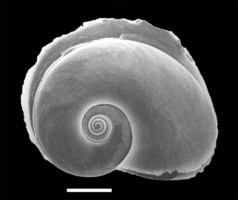
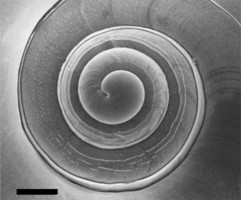
Figure. Shell of Atlanta plana viewed from the right side (left) and the spire (right). Scale bars = 0.5 mm (left) and 0.1 mm (right). © Roger R. Seapy
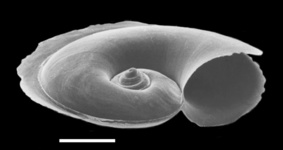
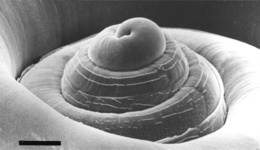
Figure. Shell of Atlanta plana in tilted view from the right side (left) and the spire (right). Scale bars = 0.5 mm (left) and 0.1 mm (right). ©
- Larval shell with a low conical spire, composed of rounded whorls and incised sutures (see second SEM below). Two spiral ridges are present on the second whorl and extend onto the third whorl. A raised, thin spiral ridge is located on the outer edge of the shell whorls, begining at the same point as the spiral ridges on the second whorl and continuing to the shell aperture (see first SEM below)
- Eyes type a, without a transverse slit in the distal pigmented tissue
- Operculum type b (micro-oligogyre)
- Gyre of operculum small, bearing a spiral row of up to 35-40 outwardly-directed, narrow, low spines (see second photograph below)
- Gyre of operculum small, bearing a spiral row of up to 35-40 outwardly-directed, narrow, low spines (see second photograph below)
- Radula type I
- Number of tooth rows unlimited
- No sexual dimorphism in teeth or in radula size or shape
 Click on an image to view larger version & data in a new window
Click on an image to view larger version & data in a new window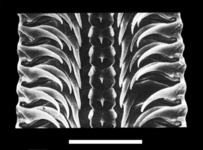
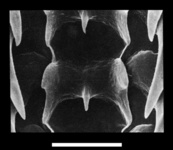
Figure. Radula of Atlanta plana; section of radula with about 5 rows (left) and close up of two central teeth (right). Scanning electron micrographs from Richter (1987, figs. 48 and 56), modified by addition of scale bars (= 100 µm and 25 µm, respectively). © 1987 G. Richter
Comments
The shells of Atlanta plana and A. gaudichaudi are very similar in appearance (discussed by Richter, 1974 and Seapy, 1990a). Both species are moderately small (maximal shell diameters of 3 and 4 mm, respectively) and have spires composed of about the same number of whorls (3-1/2). The spires in both species have a low conical shape with incised sutures. The shells differ most conspicuously in the presence (A. plana) or absence (A. gaudichaudi) of spiral sculpture on the second and third spire whorls. Their soft part morphologies also differ; the eye types are different (a and b, respectively), and the opercular gyres either possess (A. plana) or lack (A. gaudichaudi) spines.
Atlanta plana can be an abundant species in Hawaiian waters (Seapy, 1990a,b and 2008), with the result that it is well suited for quantitative ecological studies. Diel patterns of vertical distribution of heteropods were examined based on replicated, opening-closing net samples (Seapy, 1990b). Atlanta plana ranged downward to 200 m during the day, although it was only abundant in waters shallower than 90 m. At night there was an upward migration that was most pronounced from the 45-90 m depth interval into the upper 45 m of the water column. In the 2008 study, which was based on duplicated, opening-closing MOCNESS sample series, the species ranged downward maximally to 160-200 m at a station 5 nmi off the coast (comparable in location to the area sampled in the 1990b study). Similar to the earlier findings, densities were higher in the upper 40 m during the night than the day, although the differences were far less striking. Onshore-offshore comparisons of abundance patterns were markedly different between fall and spring sampling periods; maximal numbers were recorded at the 5 nmi station in the fall, while abundances in the spring decreased progressively shoreward by three-fold from a maximum at the 15 nmi station to a minimum at the 1 nmi station.
References
Richter, G. 1974. Die Heteropoden der "Meteor"-Expedition in den Indischen Ozean, 1964/65. "Meteor" Forschungs-Ergebnisse (D) 17: 55-78.
Richter, G. 1987. Zur Kenntnis der Gattung Atlanta (III), Atlanta inflata, A. helicinoides, A. echinogyra und A. plana (Prosobranchia: Heteropoda). Archiv für Molluskenkunde 117: 177-201.
Seapy, R. R. 1990a. The pelagic family Atlantidae (Gastropoda: Heteropoda) from Hawaiian waters: a taxonomic survey. Malacologia 32: 107-130.
Seapy, R. R. 1990b. Patterns of vertical distribution in epipelagic heteropod molluscs off Hawaii. Marine Ecology Progress Series 60: 235-246.
Seapy, R. R. 2008. Offshore-inshore and vertical distributional patterns of heteropod mollusks off leeward Oahu, Hawaii. Marine Biology 154: 985-995.
Title Illustrations

| Scientific Name | Atlanta plana |
|---|---|
| Location | Hawaiian waters |
| Specimen Condition | Live Specimen |
| Sex | Female |
| Life Cycle Stage | adult |
| View | right side |
| Image Use |
 This media file is licensed under the Creative Commons Attribution-NonCommercial License - Version 3.0. This media file is licensed under the Creative Commons Attribution-NonCommercial License - Version 3.0.
|
| Copyright |
©

|
About This Page

California State University, Fullerton, California, USA
Correspondence regarding this page should be directed to Roger R. Seapy at
Page copyright © 2011
 Page: Tree of Life
Atlanta plana .
Authored by
Roger R. Seapy.
The TEXT of this page is licensed under the
Creative Commons Attribution License - Version 3.0. Note that images and other media
featured on this page are each governed by their own license, and they may or may not be available
for reuse. Click on an image or a media link to access the media data window, which provides the
relevant licensing information. For the general terms and conditions of ToL material reuse and
redistribution, please see the Tree of Life Copyright
Policies.
Page: Tree of Life
Atlanta plana .
Authored by
Roger R. Seapy.
The TEXT of this page is licensed under the
Creative Commons Attribution License - Version 3.0. Note that images and other media
featured on this page are each governed by their own license, and they may or may not be available
for reuse. Click on an image or a media link to access the media data window, which provides the
relevant licensing information. For the general terms and conditions of ToL material reuse and
redistribution, please see the Tree of Life Copyright
Policies.
- First online 21 March 2010
- Content changed 23 July 2011
Citing this page:
Seapy, Roger R. 2011. Atlanta plana . Version 23 July 2011 (under construction). http://tolweb.org/Atlanta_plana/28770/2011.07.23 in The Tree of Life Web Project, http://tolweb.org/




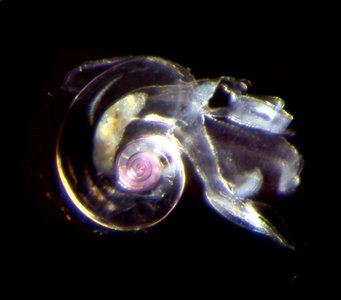
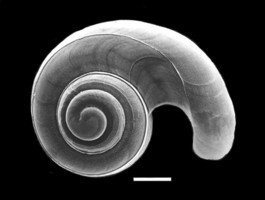
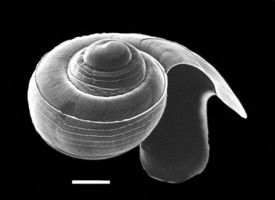
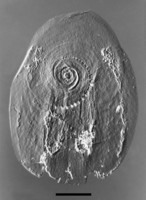
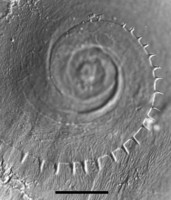



 Go to quick links
Go to quick search
Go to navigation for this section of the ToL site
Go to detailed links for the ToL site
Go to quick links
Go to quick search
Go to navigation for this section of the ToL site
Go to detailed links for the ToL site